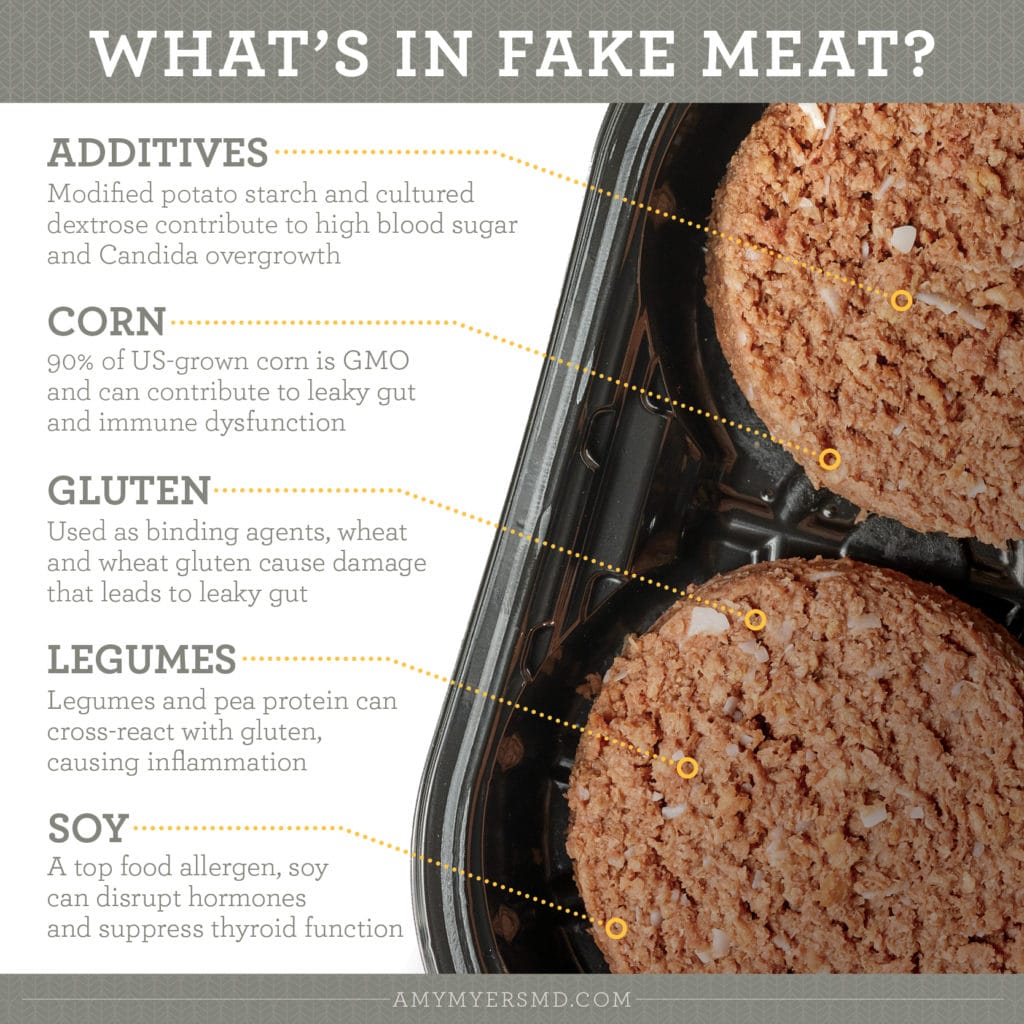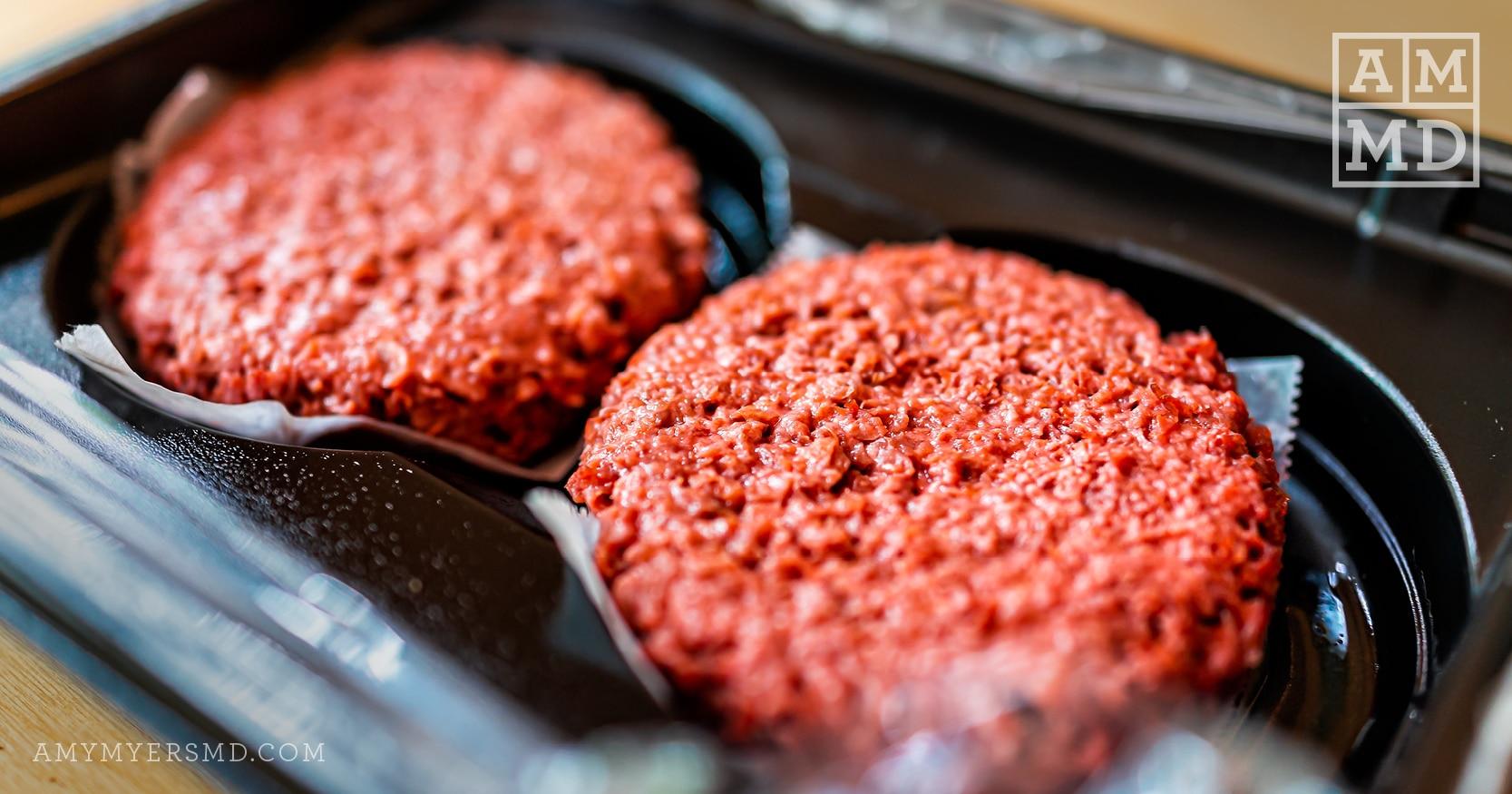Food that is great-tasting, nutrient-dense, and satisfying is an important part of a healthy lifestyle. Recently, however, new alternatives to animal protein are making a big splash on the market, these include vegetarian and vegan meat substitutes, AKA fake meat.
These faux meats, usually used for vegetarian “hamburgers,” have been popularized nationwide on fast-food restaurant menus as an alternative to burgers made with ground beef. I was a vegetarian myself for 27 years, so I can understand why this fake meat could be appealing. Yet, now I know that my meat-free diet relied on foods including gluten and dairy that wreaked havoc on my body.
If you, like me, don’t like the sensation of eating meat, opt for one of my Paleo Proteins, like my delicious Vanilla Bean Paleo Protein. All my proteins are sourced from non-GMO, grass-fed beef and have 21 to 26 grams of protein per serving, depending on the flavor.
They’re a much better alternative than the faux meat from companies such as Impossible™ Foods and Beyond Beef™. Let me explain why.
What’s In Fake Meat?
A juicy burger may not sound appealing to someone who doesn’t eat meat. However, that’s not the audience companies such as Impossible™ foods are hoping to satisfy. They’re targeting omnivores who want to reduce their meat consumption1 — whether for environmental or personal reasons — and have turned to “plant-based” foods.
Many people believe that fake meat can be healthier than real meat. However, that is not the case. When it comes to food, if you can’t pronounce it and it’s not found in nature, you don’t want to eat it.
 Dr. Amy Myers
May 31st, 2020
https://content.amymyersmd.com/article/fake-meat-is-a-problem/What’s In Fake Meat? – Infographics – Amy Myers MD®
Dr. Amy Myers
May 31st, 2020
https://content.amymyersmd.com/article/fake-meat-is-a-problem/What’s In Fake Meat? – Infographics – Amy Myers MD®The Problems With These Alternatives
These burgers swap out meat for alternatives that contain a variety of highly processed items that I can’t recommend. These include:
1. Additives
Faux meat brands use additives such as:
Modified potato starch: a plant starch whose chemical structure has been modified through physical or chemical process. Modified starches such as potato starch can withstand high temperatures and are often used as a thickening agent.2 Modified food starches are high in carbohydrates, spike blood sugar, and are essentially empty calories.
Cultured dextrose: a cultured food product made by fermenting glucose with a probiotic called Propionibacterium freudenreichii, which is derived from dairy and used in the production of cheese.3,4 The combination of sugar and dairy is a recipe for gut disaster, especially if you are dealing with Candida overgrowth.
2. Corn
The percentage of U.S.-grown corn that is genetically modified is greater than 90%, and there are corn-derived ingredients in many meat alternatives.
They can contribute to leaky gut through the use of a corn-specific insecticide known as Bt-toxin.5
3. Gluten
GMOs have been linked to numerous issues associated with gut health including IBS and diseases that impact the immune system.6
Wheat and wheat gluten are common ingredients in many popular vegetarian meat alternatives. They’re used as a stabilizing agent in food (think of traditional Italian meatballs with breadcrumbs).
Gluten is one of the two foods I recommend everyone avoid. It can cause the tight junctions of your gut wall to break apart and lead to a leaky gut. A leaky gut allows toxins, microbes, and undigested food particles to escape from your intestines and travel throughout your body. Gluten can also contaminate ingredients through contact with processing equipment.
While Impossible™ Meat products no longer officially contain gluten, even certified gluten-free foods can contain up to 20 parts per million (ppm) of gluten per serving.7
4. Legumes/Pea Protein
Legumes are another inflammatory food that may harm gut health, especially if you have an autoimmune disease. This is due to the presence of lectins which can cross-react with gluten.
While processing legumes usually strips them of the hull, reducing lectins and phytic acid, they can still contain small amounts. Additionally, pea protein may be cross-contaminated with gluten, even when it’s supposed to be gluten-free.8
5. Soy
This is one of the top food allergens. In many of us, our bodies may confuse soy with gluten, leading to the same problems gluten causes. It’s difficult for your body to digest and can be hormone-disrupting. Soy can also suppress the thyroid gland by inhibiting iodine absorption in the body. Plus, more than 90% of soy grown in the U.S. is a GMO.
Fake meat brand Impossible™ Foods uses an ingredient called soy leghemoglobin, which the FDA considers soy hemoglobin a color additive.9 This is meant to mimic the juicy, savory, meaty taste of a burger which is produced from a iron-rich molecule known as heme found only in animal proteins such as beef.
To make this additive, soy leghemoglobin gene is extracted from the root of the soybean and inserted into a strain of yeast. The genetically modified soy leghemoglobin (which comes from genetically modified soybeans), is then added to the Impossible™ meat.10
The Myths and Facts about Fake and Real Meat
With all of these questionable ingredients, why are these mock meats viewed as a better alternative to real beef? Here are some common myths I’ve heard about meat and the truth about why it should be a part of your healthy diet.
Environmental Concerns
Myth: Fake meat is better for the environment because the beef industry produces excessive greenhouse gasses and destroys the environment.
Fact: Ingredients such as pea protein and canola oil also contribute to greenhouse gas emissions, energy use, and land use. You can read more about greenhouse gases in this article.
Fat and Cholesterol
Myth: Meat is rich in fat and cholesterol and causes increased blood cholesterol levels and coronary heart disease.11
Fact: Lean red meat, trimmed of excess fat, does not increase cardiovascular risk factors. It contains protein that’s easy for your body to use, as well as vitamins and minerals your body needs.12
Nutrition
Myth: Fake meat is a good source of essential nutrients including vitamins and minerals.
Fact: Fake meat is also missing key beneficial fatty acids, vitamins and minerals found in animal protein such as vitamin B12. Additionally, heme-iron is the most bioavailable form of iron, and it can only be found in real animal protein.
Overall Health
Myth: Fake meat is a safe, healthy alternative to real meat.
Truth: GMOs are a cause for concern from the soy in fake meat. There is little research on the long-term effects of the ingredient soy leghemoglobin because it was only recently extracted from soybean roots and modified for food processing before Impossible™ Foods’ meat products. Studies on rats fed soy leghemoglobin showed unexplained changes in weight and inflammation markers in the blood.13
Sodium
Myth: Meals featuring beef products are full of sodium.
Fact: Most often, the sodium boost comes from toppings and condiments such as pickles, bacon, cheese, mustard, etc. that may also be used on fake meat burgers. Further, a fake meat patty itself has nearly 400 mg of sodium.14
Vegan/Vegetarianism
Myth: Avoiding meat is the best diet for a healthy body.
Fact: As a doctor, I don’t recommend a vegan or vegetarian diet including vegetarian meat substitutes for optimal health. Avoiding meat can make it difficult to get enough essential nutrients including iron, vitamin B, and even protein. Beans, grains, and dairy can lead to leaky gut and increased inflammation throughout your body.
What to Choose Instead of Fake Meat
I recommend sourcing your organic meat from local farms. You could also shop at local grocery stores that purchase fresh, organic meat from farmers who practice sustainable farming. If you can’t find ground meat you trust, you can grind it yourself in a food processor.
If you are not a big meat eater, consider supplementing your protein intake with one of my protein-rich Paleo Proteins such as Double Chocolate. It’s packed with 26 grams of protein. It’s gluten, dairy, and sugar-free, and sourced from non-GMO, hormone- and antibiotic-free, grass-fed beef (don’t worry, you would never know it from the delicious taste!). You also won’t find other ingredients on your ‘avoid’ list including grains, corn, or legumes in my Paleo Protein. It’s truly perfect for everyone!

Article Sources
- https://www.asbmb.org/asbmb-today/industry/100119/biochemistry-of-a-burger.
- https://www.home-ec101.com/what-is-modified-food-starch/.
- https://en.wikipedia.org/wiki/Cultured_dextrose.
- https://www.livestrong.com/article/549933-what-is-cultured-dextrose/.
- https://www.ncbi.nlm.nih.gov/pubmed/22337346.
- https://www.gmoscience.org/777-2/.
- https://www.glutenfreedietitian.com/how-much-gluten-is-20-parts-per-million/.
- //plantproteinmonth.com/faqs.php.
- https://www.fda.gov/news-events/fda-brief/fda-brief-fda-approves-soy-leghemoglobin-color-additive.
- https://www.gmoscience.org/impossible-burger-boon-risk-health-environment/.
- .
- https://www.ncbi.nlm.nih.gov/pubmed/15927927.
- https://www.gmoscience.org/rat-feeding-studies-suggest-the-impossible-burger-may-not-be-safe-to-eat/.
- https://www.health.harvard.edu/blog/impossible-and-beyond-how-healthy-are-these-meatless-burgers-2019081517448.
